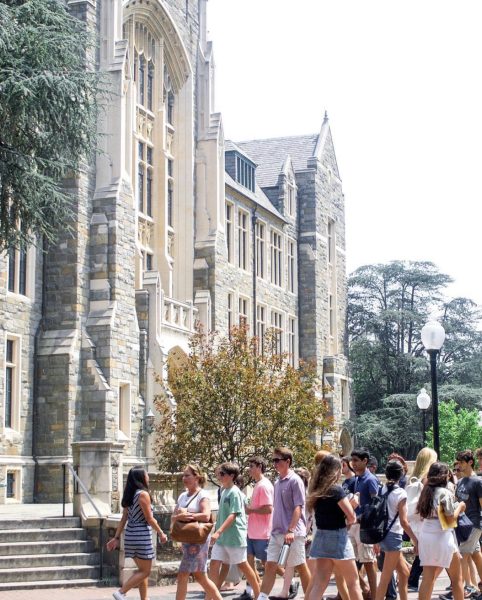When Ethan Henshaw (CAS ’26) heard the Supreme Court had ruled against affirmative action, he saw Georgetown as facing a different issue from many other elite national universities.
“I just remember being a student on the ground and seeing it,” Henshaw told The Hoya. “Certainly the problem at Georgetown is not that it’s too diverse, but that it’s not diverse at all.”
Henshaw said the ruling on affirmative action would only exacerbate Georgetown’s lack of diversity and said he found the arguments of opponents of affirmative action frustrating.
“Watching all these people rally against affirmative action was just really infuriating,” Henshaw said. “Because, I mean, we’re at a school right now where there are more legacy students than there are Latino students, more legacy students than there are Black students. And we’re just fighting the wrong thing.”
Georgetown University accepted 12% of applicants for the undergraduate Class of 2028 — a one percentage point decrease from the Class of 2027 — according to a university spokesperson.
A university spokesperson did not respond to The Hoya’s question regarding what percent of accepted students in the Class of 2028 are legacy students.
Following the ruling against affirmative action, Henshaw and other Georgetown students formed Hoyas Against Legacy Admissions, a campaign that aims to end the university’s practice of legacy admissions, preference given to applicants with a familial connection to alumni. Of Georgetown’s admitted Class of 2024, the most recent year with available data, 9% were legacy students.
The campaign has met with university administrators, sought support from faculty and reached out to students to make the case against legacy preference, with hopes to impact the next admissions cycle.
Georgetown Accepts 12% of Applicants
The university admitted 3,226 students out of 26,170 total applicants, according to an email Dean of Undergraduate Admissions Charles Deacon (CAS ’64, GRD ’69) sent to alumni interviewers which The Hoya obtained.
The McDonough School of Business (MSB) had the lowest acceptance rate, admitting 517 of 4,554 applicants for an acceptance rate of 11%, according to Deacon’s email. The College of Arts & Sciences (CAS) had the most applicants, admitting 1,870 of its 15,704 applicants, an acceptance rate of 12%. The Walsh School of Foreign Service (SFS) admitted 15% of its 3,917 applicants. The School of Health (SOH) admitted 12% of its 1,484 applicants. The School of Nursing (SON) admitted 15% of its 511 applicants.
Georgetown admitted 10% of early action applicants in December. Legacy status is not considered for early action applicants.
Deacon said the university received excellent applicants from all parts of the United States and around the world.
“They indicate that they are particularly attracted to the national and international reputation of the University and its students,” Deacon wrote to The Hoya. “They also stress the University’s commitment to social justice and frequently speak about the attraction of the Jesuit ideals of cura personalis.”
“As for legacy I can’t speak to that except to say that a working group has been convened to examine this issue so it is being addressed,” Deacon added.
Demographics on students’ racial and ethnic identities will not be available to the university until after students enroll.
The mid-50% of SAT math scores of students admitted this year ranged from 730 to 790, while the mid-50% of SAT verbal scores ranged from 730 to 770, according to a university spokesperson. The mid-50% of ACT scores fell between 32 and 35. The average admitted student was in the top 6% of their class.
Georgetown admitted students from all 50 states, Washington, D.C. and Puerto Rico, according to a university spokesperson. The university offered acceptances to international students from 94 countries of citizenship and 513 students with dual citizenship.
Talia Udelman, a high school senior from Phoenix, Ariz. who was admitted regular decision to the College, said she applied to Georgetown because of its location.
“Since it’s in D.C., you have so many opportunities out and about,” Udelman told The Hoya. “You can go and try and get an internship on Capitol Hill. You can intern with some law firms as well.”
Udelman, who is half Mexican Catholic and half Lithuanian Jewish, said she worried the Supreme Court ruling would negatively impact her application.
“I did feel kind of nervous about it initially, being of mixed race,” Udelman said. “It did feel like it would have some factor in which schools I got into.”
Udelman said she believes legacy admissions should be at least restricted, if not banned, in order to make admissions more fair.
“Even if legacy students are qualified to be a part of the incoming class, I just feel that they’re given kind of a step up above other applicants and it may not be fair in a lot of cases,” Udelman said. “Even if they are qualified, they’re just starting from a higher playing field.”
Nina Park, a high school senior originally from South Korea but who lives in New Jersey and was admitted regular decision to the College, said that, as an Asian woman, many people expected the Supreme Court ruling to have a positive effect on her application.
“I don’t really know if that influenced me in any way, though,” Park told The Hoya. “I know it’s technically supposed to influence me. But given the results that I got this college regular decision cycle, I think there’s not much that has changed.”
The Case Against Legacy Admissions
The Georgetown University College Democrats (GUCD) created the initial campaign against legacy admissions in August, releasing a petition that over 1,100 community members have signed as of April 4. Members soon created their own organization, Hoyas Against Legacy.
Darius Wagner (CAS ’27), a member of Hoyas Against Legacy, said he joined the campaign to ensure that overlooked communities have fair access to higher education and opportunities.
“Especially with my background, as a Black, first-gen student, I believe everybody deserves a fair shot,” Wagner told The Hoya. “And in the wake of the Supreme Court’s ruling against affirmative action, I know it’s necessary that we must take action.”
Before the Supreme Court ruling, in Fall 2022, only 7% of Georgetown undergraduates were Black, compared to 14% of 18-24 year olds in the United States who are Black. Additionally, 8% of undergraduates were Hispanic, compared to 24% of 18-24 year olds in the United States who are Hispanic.

Wagner said the lack of diversity on campus is apparent to him and other students.
“As a first-gen Black student, you feel it,” Wagner said. “It’s not something that’s hidden. You feel it.”
Asher Maxwell (CAS ’26), another member of Hoyas Against Legacy, said that, despite claiming it is committed to diversity, the university has not made much progress in recent years.
“If we’re talking about building a student body that looks like the country, Georgetown gets an F, and it’s not even close,” Maxwell told The Hoya. “And that was before the affirmative action decision.”
A university spokesperson said the university pursues all available efforts to create and support a diverse student body.
“We have developed initiatives to recruit a student body comprised of people with abundantly diverse backgrounds, as well as programs to ensure they feel welcome at the university, such as the Georgetown Scholars Program, which supports first-generation and low-income college students in their time on the Hilltop,” a spokesperson wrote to The Hoya.
The percentage of non-white students at Georgetown saw marginal increases from 2012 to 2021, when the most recent data was available, while the percentage of white students decreased from 60% in 2012 to 49% in 2021.
A report by the Georgetown University Center on Education and the Workforce that President DeGioia included in a letter to community members after the Supreme Court ruling concluded that ending legacy admissions was the first and most impactful step to prevent a loss in schools’ diversity.
Universities like Johns Hopkins University and Amherst College have seen a rise in racial diversity after ending legacy admissions.
Henshaw said, though the ban on legacy admissions at Johns Hopkins was paired with other steps, it showed the impact that accepting students based on legacy has on the student body’s racial diversity.
“If you get rid of those preferences, you’re opening up more spots — who knows how many spots — but you’re opening up more spots for students who, traditionally, were gonna get blocked out because those are being saved for students who can pay the full price,” Henshaw said.
Maxwell said members of the campaign have met with university administrators since the affirmative action ruling and said he has seen no signs from university administrators that they are taking the threat to the school’s diversity seriously.
“We were told that President DeGioia wanted to take time to consider the issue,” Maxwell said. “The other administrators defended the policy and said that there was no real avenue for that policy to end.”
Economic Diversity Concerns, Pivoting to a Legislative Route
Hoyas Against Legacy said Georgetown also has a lack of economic diversity.
The New York Times’s College Access Index ranked Georgetown 230th out of 283 selective universities in September in economic diversity, based on its number of enrolled Pell Grant recipients in 2021.
In 2017, more Georgetown students were from the top 1% of family incomes than the bottom 60%. Applicants from the top 1% are 10.8 times more likely to be accepted to Georgetown than an average-income student. Among students with equal test scores, those from the top 1% are 2.7 times more likely to be accepted.
Georgetown’s percentage of Pell Grant recipients increased from 10.4% in 2007 to almost 16% in 2015 but dropped to 9.1% in 2021.
Henshaw, who is a Pell Grant recipient, said he felt many students at his high school were qualified but could not get into top schools like Georgetown because they did not have connections or money.
“Almost everyone here is incredibly wealthy, having got some sort of preference because their parents could donate, their parents went to the school, their parents could pay the price, who their parents were, the high school they went to,” Henshaw said.
A university spokesperson said Georgetown carefully considers all applicants and makes its admissions process as personalized as possible.
“Georgetown University only admits students who will contribute to the academic rigor and thrive in our community,” the university spokesperson wrote.
Wagner said Georgetown’s relatively static number of Pell Grant recipients shows the university is failing to live up to its values of having equal access.
“It’s clear that we’re not striving to lead the pack on this issue and that we’re falling behind,” Wagner said.
Deacon said the university is working to increase its Pell Grant population as well as its financial aid program.
Additionally, DeGioia said in September the university would begin to weigh socioeconomic factors in admissions.
Maxwell said the university has not shown them a mechanism or new policy to implement such a commitment.
“They haven’t said that they’re adopting some sort of class conscious admissions in any real way, or that they’ll be giving some sort of boost to students from underrepresented socioeconomic backgrounds, students who aren’t coming from the top 20 or the top 1%,” Maxwell said.
After they felt that meetings with university administrators led to no change, members of Hoyas Against Legacy decided to pursue other ways to ban legacy admissions.
The campaign has met with 11 of the 13 members of the D.C. Council, nine of whom say they support a bill to end legacy admissions, according to Wagner.
“Surprisingly, we’ve gotten more hope from the City Council than we have from our own admissions office,” Wagner said.
Members of Hoyas Against Legacy also spoke to the D.C. State Board of Education and said they have two thirds of the board’s support. They added that 70% of the District’s residents support ending legacy admissions.
“We’re very confident that legacy and donor admissions will be banned by this time next year,” Maxwell said. “And I say that with a lot of confidence.”
Wagner said an institution like Georgetown that was founded on Jesuit principles should try to make as many fair opportunities for students as possible.
“I think we should look at the values that we pride ourselves on, or that we carry ourselves on, founded ourselves on as an institution, and really apply that to the work that we do,” Wagner said. “We should be making the admissions field a more level playing field. We should be looking for communities that are often overlooked, because there’s real talent there.”










DR • Apr 22, 2024 at 8:51 am
“The percentage of non-white students at Georgetown saw marginal increases from 2012 to 2021, when the most recent data was available, while the percentage of white students decreased from 60% in 2012 to 49% in 2021.”
Henshaw’s claim that there is no diversity is ridiculous. If the statistics in the article are accurate, GU is much less “white” than the U.S. as a whole, which is 71% white according to the most recent census. The story also doesn’t mention that many minority students nationwide prefer to attend an HBC.
Udelman’s story proves that minority students don’t need special preferences to be admitted to GU.
I don’t support legacy admissions and I have no problem with GU ending preference for children of alumni. Still, one should realize that on average legacy applicants are probably more prepared for college (and the application process) than most high school students, so even without preferential treatment there would probably be a lot of legacy students on campus.